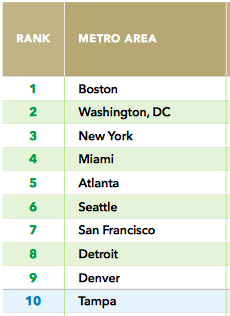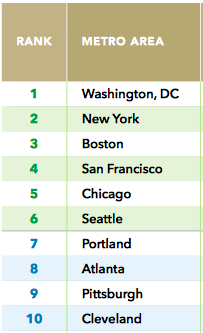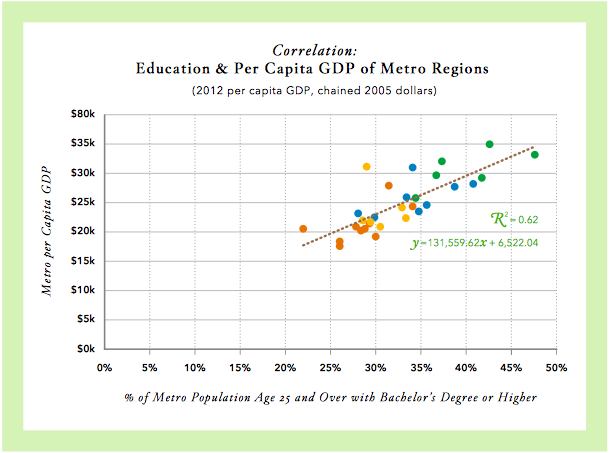To get the economy humming again, America's metro regions need to build more walkable places, according to a new report from a coalition of real estate developers.
The report from LOCUS [PDF], a group of developers and real estate investors who specialize in building walkable projects, examines which regions are seeing the fastest growth in walkable urban places, which the group calls "WalkUPs." These places can be in cities or suburbs -- political boundaries make little difference when it comes to walkability.

WalkUPs account for just 1 percent of total land area in the 30 metros LOCUS examined, but they have captured 48 percent of new rental housing, retail, and hotel development since 2009, according to the study. Unlocking the potential of these areas is the key to getting the real estate market and, in turn, the American economy, back on track, LOCUS says. The group believes that in the next few decades WalkUPs could capture as much as 80 percent of new development.
By measuring the share of development that goes toward walkable places, as well as the price premium that type of development commands, LOCUS rated the potential for walkable growth in each region (right).
"What we’re seeing here is a trend that is a structural trend," said Chris Leinberger, president of LOCUS and co-author of the study. "The last structural trend was in the 1940s when we left the central cities."
But there are many obstacles to walkable development: zoning laws and car-oriented transportation infrastructure, to name a few major ones. And some places are doing a better job of capturing that growth.
"We think this is going to take at least 10 to 20 years to catch up with the trend," said Leinberger.
Here's what LOCUS learned from its examination of 558 WalkUPs in 30 metro areas.
1. People will pay a premium to locate in walkable places

According to the LOCUS analysis, walkable urban places command a 74 percent premium for office rents across the 30 metro areas. Excluding New York City, with its anomalously high rents, the average premium was 44 percent.
What the price premium reveals is the pent-up demand for walkable places. But everything from local zoning regulations to finance industry formulas makes it tougher to build this type of project.
"These things are very complex to put together," said Leinberger, "unlike drivable suburbanism where there is a formula. This is not a formula where you just turn the crank."
Rod Lawrence, a partner at the JBG Companies, a Washington-based developer, said completing a walkable development project can take five to 10 years, because of regulatory hurdles and resistance from neighbors.
"Getting zoning and infrastructure changed to allow for this, it hasn’t been an easy process," he said. "A lot of the department of transportation staff is not prepared for building urban streets. They’re trained for buiding highways."
2. Demand for walkable places is increasing
Since 2007, the premium for office rents in walkable urban locations has increased 19 percent. That means development of WalkUPs isn't happening fast enough to meet growing demand.
This presents an affordability problem, especially for housing. The supply of walkable areas is constrained -- there are a limited number of them in the United States -- so prices are too high.
Instead of building sufficient walkable development to meet demand, Leinberger said, "in the United States our unofficial affordable housing strategy is 'drive until you qualify.'"
3. Walkable places are linked to stronger economic performance and higher educational attainment (but causation could run either way)

In the most walkable regions LOCUS identified, per-capita GDP was 50 percent higher (about $60,500) than in the three cities that ranked lowest on walkability ($39,700).
Educational attainment -- percentage of the population over 25 with a college degree -- was also correlated with walkability. Washington, D.C., for example, which was rated the most walkable region in LOCUS's report, also has the highest educational attainment in the country: 48 percent of its residents over 25 have at least a bachelor's degree.
But researchers aren't sure whether walkability is a cause or effect (or both), or whether there's another variable at work.
"They’re pretty strong correlations," said Patrick Lynch, research and development manager at George Washington University's Center for Real Estate and Urban Analysis. "The correlation doesn’t tell you anything about why."
4. Urbanization of the suburbs is the next frontier
The places expected to grab the largest share of walkable development in the coming years are regions seeing dense development not just in their central cities, but in their suburbs as well, LOCUS reports. Detroit, surprisingly, is a place that's becoming more urban. That's because the Detroit region has seen a large share of its growth recently in increasingly walkable suburbs like Royal Oak and Birmingham, the report says. Meanwhile, cities like Philadelphia, Chicago, New York, and Cleveland lost points in the ranking of cities with potential for walkable growth, because their walkable development is still largely concentrated in the central city area and not the suburbs.





